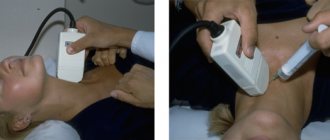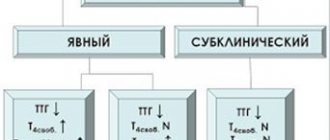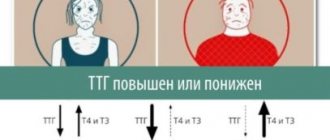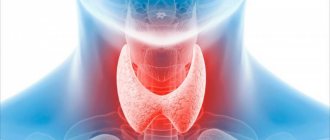General information
There is not a single organ in the human body whose function is not affected by the thyroid gland. She is a kind of “conductor” of metabolism.
The “thyroid gland” is located in front at the bottom of the neck at the level of the 2-3rd ring of the trachea under the larynx, and consists of two lobes connected by an isthmus. The shape resembles a butterfly.
The scientists who first described the gland had an association with the shield, which gave it its corresponding name. The organ is quite small, and in a healthy state it is practically invisible to the person himself.
What is the thyroid gland responsible for?
The thyroid gland is an important organ of the endocrine system.
It produces iodothyronine hormones (also known as thyroid hormones), which participate in catabolic processes and regulate many vital parameters of the body. For example: blood pressure, heart rate, respiratory rate.
Reference! Catabolism is the process of breaking down complex substances into simpler ones, which occurs with the release of energy. Catabolic processes include processing food or burning fat cells.
The organ indirectly affects vascular tone, cell and tissue regeneration processes. We can say that the gland is responsible for the entire metabolism of the human body.
Thyroid gland – hormones
The thyroid gland secretes polypeptide iodine-containing hormones: triiodothyronine (T3) and thyroxine (T4), which are produced by its follicular cells. The command for their secretion is the release of thyroid-stimulating hormone (TSH) by the pituitary gland. Another hormone, calcitonin, regulates the metabolism of calcium and phosphorus. It is extremely important for healthy bone metabolism.
To effectively produce hormones, the thyroid gland needs iodine and the amino acid tyrosine. The human body receives all this from food.
History of ultrasound
Ultrasonic vibrations were discovered by Italian scientist Lazzaro Spallanzani back in 1794. While watching the bat, he wondered how it was possible to navigate in space at night while flying. It turned out that this is carried out using high-frequency sound vibrations, inaudible to humans. But animals, particularly bats, perceive them very well. The principles of echolocation are also used by marine animals - killer whales, dolphins, whales, etc. Over time, they became known as ultrasonic waves.
In 1942, for the first time, the German doctor Theodor Dussick and his brother, scientist and physicist Friedrich Dussick, tried to use ultrasound to diagnose a tumor in a patient’s brain. The first medical ultrasound device was created in 1949 by the American scientist Douglas Haury.
Doppler Christian Anders made a great contribution to the development of ultrasound diagnostics. While working on his scientific work “On the collometric characteristics of the study of double stars and some other stars in the sky,” he noticed that the frequency of the signal reflected from an object depends on its speed and direction of movement. This property is called the Doppler effect, which is widely used in Dopplerography to examine blood flow parameters.
Thyroid diseases
Thyroid diseases can be divided into 2 types:
- Primary – the cause and pathological process are located in the gland itself.
- Secondary – the hormonal function of the pituitary gland is disrupted, the secretion of thyroid-stimulating hormone (TSH) changes, which in turn affects the functioning of the organ.
The dysfunction of the endocrine organ can be judged by the results of a blood test for thyroid hormones. It is also necessary to determine the amount of thyroid-stimulating hormone. Ultrasound of the thyroid gland (in some cases with Doppler), scintigraphy and tissue biopsy from suspicious areas are also performed.
Treatment
The thyroid gland is rightfully considered the queen of the endocrine system, because it controls the functioning of most organs through the production of hormones. Due to the fact that it affects the entire body, its treatment must be done extremely carefully and only under the supervision of a doctor.
If the thyroid disease is a consequence of another disease, then first or in parallel it is treated in the same way.
Depending on the cause of the thyroid disease, the diagnosis and individual medical history, the patient is prescribed treatment. The main types of treatment are:
- hormone replacement therapy;
- additional iodine intake is prescribed;
- diet enriched with vitamins and minerals;
- surgical intervention.
Experienced doctors work at Amadeus Clinic. The patient can make an appointment with one of our specialists. The medical center employs several specialists with sufficient experience. After the necessary diagnosis, the doctor you choose will be able to make a diagnosis and prescribe treatment, which will be monitored and changed if necessary. We have various payment methods for our clients.
Thyroid gland: symptoms of the disease
Hypothyroidism
If gland function is reduced, the level of thyroid hormones drops. Accordingly, metabolic processes slow down and the amount of energy decreases. A state of hypothyroidism occurs.
It is characterized by the following symptoms:
- increased fatigue;
- acute sensitivity to cold;
- dry skin;
- excess body weight;
- tissue swelling;
- hoarse voice;
- high cholesterol in the blood;
- muscle weakness;
- slow heartbeat;
- dry, brittle hair;
- memory impairment, forgetfulness;
- depression.
To correct the condition, tablets of thyroid hormones and other drugs are used. Timely treatment restores the body's condition to normal.
Chronic thyroiditis
Another name for this form of inflammation is Riedel's thyroiditis. This is the least studied type of disease.
Among its main causes, systemic immune malfunctions are suspected, which increase the activity of plasma cells. This causes the gland cells to die, leaving fibrous areas. The likelihood of getting the disease is higher in people with Graves' disease or endemic goiter (even in the past).
Symptoms of chronic thyroiditis of the thyroid gland will rarely be noticeable at the very beginning of the disease. Because of this, time is wasted when conservative therapy is effective. As the disease progresses, the patient experiences symptoms that resemble cancer. They are caused by the rapid growth of the organ:
- "Lump in the throat.
- Difficulty breathing, suffocation.
- Long cough, hoarseness in the voice.
There is no pain when pressing on the gland.
To diagnose Riedel's thyroiditis, the following are used:
- A blood test - which is characterized by the following indicators: there are anti-TPO antibodies, the TSH level is elevated in 30% of cases, and in the remaining 70% - hormonal levels are normal.
- Cytological examination of tissues from puncture. It helps to distinguish cancer from fibrous inflammation without malignancy of the tumor.
Examinations such as ultrasound diagnostics and even MRI are not very informative with Riedel's thyroiditis.
Therapy is aimed at preventing complications. If the tumor is too large and puts pressure on neighboring organs, it is partially (or completely) removed surgically. After surgery, hormone replacement therapy, drugs that suppress fibrosis in tissues, and drugs for autoimmune processes are carried out. At the initial stage, such conservative therapy often does not help - the tumor grows too quickly, so it is difficult to avoid surgery.
Hyperthyroidism
If the secretion of thyroid hormones exceeds the norm, another pathological condition develops - hyperthyroidism. Its second name is thyrotoxicosis. In this case, metabolic processes are pathologically accelerated, and an inadequate release of energy occurs from the body.
Symptoms of hyperthyroidism:
- sudden weight loss without dietary restrictions;
- tachycardia, arrhythmia;
- tremor of the hands, tremors in the limbs;
- sweating;
- feeling of heat for no external reason;
- an increase in the size of the thyroid gland, its swelling;
- Graves' ophthalmopathy (bulging eyes);
Therapy for thyrotoxicosis is aimed at suppressing the function of the gland.
It is also important to start treatment on time to avoid extreme exhaustion of the body.
Depending on gender and age, the manifestations of diseases may differ.
Thyroid gland - symptoms of dysfunction in men
Hypothyroidism:
- erectile disfunction;
- decreased sperm count;
- male infertility;
- gynecomastia (female breast enlargement);
- reduced endurance;
- slow movements;
- dry eye syndrome, corneal damage;
- holding your breath during sleep (apnea);
- snore;
- insomnia;
- Difficulty waking up in the morning, drowsiness in the 2nd half of the day.
Hypothyroidism is more severe in men than in women. It has a stronger effect on performance, but less influence on the emotional state.
Hyperthyroidism:
- increased excitability, irritability;
- attacks of fear, panic (panic attacks);
- fast fatiguability;
- headache;
- tachycardia and cardiac arrhythmia (more pronounced than in women);
- heart failure;
- decreased potency.
Symptoms in women
Hypothyroidism in women occurs somewhat differently than in men:
- weight gain is more pronounced, weight gain is not stopped by dieting;
- chronic fatigue is observed;
- chilliness;
- hair loss;
- dryness, flaking of the skin;
- constipation;
- memory impairment;
- menstrual irregularities, it becomes irregular, accompanied by painful menstruation.
All postmenopausal women experience a mild degree of hypothyroidism, but it is not clearly expressed. However, it is still worth contacting an endocrinologist. A small medicinal correction of metabolism will restore good health and mood.
Hyperthyroidism in women:
- bulging eyes (more pronounced than in men);
- sleep disorders;
- feeling of constant anxiety;
- menstrual irregularities, it becomes irregular and painful;
- rapid pulse;
- sudden weight loss;
- changes in blood pressure, most often hypertension.
The disease also causes moral suffering to representatives of the fairer sex. This is caused by a clear change in appearance for the worse. To avoid serious consequences, treatment should be started as early as possible, and not wait until the disease strikes a blow to beauty and health.
Manifestations in children
In infants, hypothyroidism is severe and affects the development of the child. Observed;
- swelling;
- excess body weight;
- puffy face;
- developmental delay.
In children of preschool and school age, hypothyroidism manifests itself as follows:
- swelling of the lower extremities and face appears;
- overweight;
- difficulty breathing through the nose;
- rough voice;
- poor circulation in the extremities, cold feet;
- chilliness;
- Delayed change of teeth.
Hyperthyroidism (thyrotoxicosis) in children has its own characteristics:
- frequent and causeless increase in body temperature;
- excitement, hyperactivity, followed by lethargy;
- sudden weight loss, extreme thinness.
If medical assistance is not provided on time, serious problems with the cardiovascular system are possible.
The thyroid gland plays an important role in the development of a child; it is important to diagnose the disease in time and begin treatment.
Acute and subacute thyroiditis.
Typically develop after a viral or bacterial infection. Acute thyroiditis can be purulent or non-purulent. Acute purulent thyroiditis develops due to the presence of a focus of chronic infection, after suffering tonsillitis, periodontitis, pneumonia, etc.
The clinical picture begins acutely and is characteristic of the inflammatory process: swelling of the gland (enlargement and pain on palpation), severe pain radiating to the lower jaw, neck, increased body temperature, chills, severe asthenia.
Laboratory examination reveals inflammatory changes in the general blood test (increased leukocyte levels, changes in the leukocyte formula, acceleration of ESR). When examining hormonal status, most often no changes are detected, but a picture of thyrotoxicosis is possible. An ultrasound of the thyroid gland reveals signs of inflammation and increased blood circulation in the gland.
Treatment: rest, antibiotic therapy, anti-inflammatory therapy with NSAIDs, identification and treatment of the source of infection.
Acute non-purulent thyroiditis is the result of trauma, hemorrhage into the gland, irradiation of the head and neck organs (post-radiation thyroiditis). It begins some time after exposure and is less acute. Treatment consists only of NSAIDs and sometimes glucocorticoids.
Subacute thyroiditis (De Quervain's thyroiditis) begins less acutely than acute thyroiditis. The cause is a viral infection. Women get sick more often.
The clinical picture is also characterized by signs of local inflammation, asthenia, pain, chills, fever to subfebrile, sometimes with signs of thyrotoxicosis. If treatment is started in a timely manner, the inflammation goes away quickly and without consequences.
Laboratory changes are characteristic of o.thyroiditis, but less pronounced.
Treatment: anti-inflammatory therapy with NSAIDs or glucocorticoids, symptomatic treatment of manifestations of thyrotoxicosis.
As a result of suffering from thyroiditis, hypothyroidism can develop, therefore, after acute and subacute thyroiditis, it is recommended to observe for 6 months with a study of hormonal status, antibody levels and ultrasound.
Thyroid goiter: symptoms
A goiter is a pathological growth of thyroid tissue. Often, a goiter does not cause significant pain and only causes discomfort when it reaches a large size.
The disease is accompanied by the following symptoms:
- tightness in the throat and difficulty swallowing, there may be a sensation of a foreign body;
- brittle hair, nails and bone fragility;
- an increase in the size of the thyroid gland until visual manifestation;
- heart rhythm disturbances, tachycardia, arrhythmias;
- hand tremors;
- ophthalmopathy (bulging eyes);
- increased fatigue and decreased performance;
- sleep disorders;
- menstrual cycle disorders in women;
- problems with potency in men.
Goiter usually leads to thyrotoxicosis.
Symptoms of different types of goiter
Depending on the location in the tissues of the organ, goiter can be diffuse or nodular:
- Diffuse toxic goiter (Graves' disease, Graves' disease). It is expressed in a uniform increase and proliferation of tissues. The growth is usually accompanied by increased secretion of hormones and the patient develops hyperthyroidism (thyrotoxicosis).
- She has an evil toxic goiter (Plummer's disease). In this case, small areas of the organ grow and change their structure. Often occurs due to iodine deficiency in the body.
Cystic is also classified as a more advanced form of nodular goiter.
A mixed type of goiter may form: diffuse-nodular , when the entire gland grows, but structurally separate nodes appear in it.
The nature of therapy depends on the type of goiter. In difficult cases, or when medications do not help, surgery is prescribed.
Thyroid diseases
First of all, it is worth understanding what kind of organ the thyroid gland is and what it affects. A person's thyroid gland is located in the front of the neck, so that the doctor can feel it during a routine examination. It is one of the organs of the endocrine system (organs that produce hormones) and is responsible for the synthesis of the hormones T3, T4 and calcitonin, which regulate the functioning of the entire body along with the immune and nervous systems.
Thyroid diseases are most common in women, as they are more susceptible to hormonal fluctuations associated with monthly menstruation, pregnancy and menopause.
The organ itself is very small, its weight in an ordinary person does not exceed 20-30 grams. The overall size of the thyroid gland is of great importance, since in some diseases it can increase or decrease and it is important to pay attention to this, however, throughout life, depending on the age of the patient, its size may change slightly.
With iodine deficiency in the body, the thyroid gland cannot synthesize the hormones necessary for the body. And iodine must be supplied to the body with food daily.
At the moment, there is no clear classification of thyroid diseases, but they can be divided into several groups:
- arising due to insufficient production of thyroid hormones (for example, hypothyroidism);
- with an excess of hormone production (hyperthyroidism);
- congenital pathologies (poorly formed organ, its absence, etc.);
- inflammatory processes (thyroiditis);
- enlargement of individual parts of the organ (any type of goiter);
- malignant and benign formations.
Hypothyroidism
This pathology occurs when there is insufficient production of the hormones T3 and T4.
Hypothyroidism is more common in women than in men. The pathology occurs in 1 man out of 1000, while 19 cases per 1000 women occur.
The disease can be asymptomatic for many years, affecting the entire body and disrupting the functioning of many organs, for example, the production of sex hormones decreases, which can lead to the impossibility of conception.
The reason for the development of this thyroid disease can be:
- congenital structural features;
- removal of an organ for any reason;
- strong radioactive exposure;
- long-term iodine deficiency;
- neoplasms in the organ;
- severe neck or head injuries;
- disturbances in brain function;
- chronic diseases of the autoimmune system, etc.
The symptoms of the disease are quite vague and can be confused with other pathologies; you should pay attention if you have:
- constant lack of energy to do ordinary things;
- frequent cramps and pain in various muscles;
- interruptions in heart function, low blood pressure;
- memory impairment;
- pale, dry and flaky skin;
- hair loss and fragility;
- decreased libido and irregular cycles in women;
- excessive swelling for no reason.
Consequences of hypothyroidism
A long-term stay in a lack of hormones can seriously affect a person’s overall health, so in adults problems with the myocardium may begin, endocrine infertility may occur, the menstrual cycle in women may disappear, myxedema, and the worst thing is hypothyroid coma.
Children may experience mental and physical retardation, cretinism, heart disease and low immunity.
Thyrotoxicosis (hyperthyroidism)
This disease is the opposite of the previous one (hypothyroidism), its essence is that the thyroid gland begins to produce an excess amount of its hormones T4 and T3. At the same time, metabolic processes in the body are accelerated, which leads to the development of pathologies in other organs. The heart muscle and nervous system are most affected by hyperthyroidism.
Women of childbearing age (20-45 years) are most susceptible to this pathology.
The reason for the development of thyrotoxicosis can be:
- the most common cause is nodular toxic goiter;
- taking synthetic hormones;
- hereditary predisposition;
- neoplasms of the pituitary gland and thyroid gland.
Symptoms of this thyroid disease in women:
- sweating;
- feeling of a lump in the throat due to an increase in the size of the thyroid gland;
- cardiopalmus;
- constant feeling of thirst;
- sudden weight loss;
- irritability and mild excitability;
- insomnia may be present;
- Itching and heat intolerance may occur;
- from the intestinal tract, diarrhea, lack of appetite and abdominal pain may be observed;
- menstrual irregularities, etc.
Consequences of hyperthyroidism
If drug treatment is not started in time, then in case of advanced disease:
- Surgery may be necessary to remove part or all of the thyroid gland;
- a tumor forms;
- complications on the vocal cords and larynx;
- disturbances in the functioning of the heart.
Autoimmune thyroiditis (AIT)
The disease means chronic inflammation of the thyroid gland, since it was first described by the Japanese surgeon Hashimoto, it has a second name - Hashimoto's thyroiditis. With this disease, the thyroid cells are gradually destroyed and its function is impaired.
AIT can be asymptomatic, but in the future it causes complications in many body systems: it disrupts the functioning of the heart and metabolic processes.
The success of treatment depends on high-quality diagnostics, which is aimed at identifying the form and cause of the disease. There are four main types of AIT:
- chronic – occurs due to excessive growth of T-lymphocytes (most common);
- postpartum – develops due to instability of a woman’s hormonal levels during pregnancy; with timely detection, normal functioning of the gland can be quickly restored;
- painless - is the most dangerous, as it can appear spontaneously and develop unpredictably, the main way to diagnose it is an annual examination by an endocrinologist, an ultrasound scan and blood donation for hormones;
- pharmacological - appears as a result of taking drugs that affect the liver and blood; it is the most complex form, as it is difficult to treat.
Unfortunately, it is impossible to completely get rid of AIT, but treatment removes the symptoms of the pathology and prevents the condition from worsening.
Factors that provoke the development of autoimmune thyroiditis, in addition to those described above, may be:
- mutations in genes;
- abnormal intake of iodine;
- stress;
- chronic infections.
Signs of thyroid disease include:
- a constant state of apathy;
- weight fluctuations for no apparent reason;
- skin aging and hair loss;
- there may be changes in the voice, hoarseness or sore throat;
- increase in throat volume;
- trembling legs or arms;
- mood variability towards aggression and irritability.
Consequences of Hashimoto's thyroiditis
If autoimmune thyroiditis is not treated, a state of chronic hypothyroidism may occur: a constant lack of thyroid hormones, which will lead to the need to take hormonal therapy for the rest of life. The formation of toxic goiter or the development of malignant thyroid lymphoma is possible.
Goiter
The most common pathology is endemic goiter. This is a condition in which the thyroid gland becomes enlarged due to iodine deficiency. The gland begins to grow, and its functionality changes.
More rare causes of goiter development are:
- genetic predisposition;
- disorders of hormonal synthesis;
- deficiency of elements that are involved in maintaining the functioning of the thyroid gland (copper, zinc, manganese, etc.;
- taking medications that interfere with iodine transport;
- chronic infections, worms.
In the structure of endemic goiter, several forms can be distinguished:
- diffuse (persistent disruption of hormone secretion);
- nodular (usually does not interfere with the functioning of the thyroid gland);
- mixed.
Symptoms of this thyroid disease are:
- enlargement of the gland (with nodular goiter, protrusion from the neck area is observed);
- brittle hair and nails, hair loss;
- irritability.
Depending on the type of goiter, symptoms may or may not be present. In general, the symptoms are no different from other thyroid diseases.
Consequences of endemic goiter
The disease brings serious inconvenience with significant enlargement of the organ, for example:
- squeezing in the throat, causing disruption of the blood vessels, nerves and esophagus;
- hemorrhage into the thyroid gland;
- strumit;
- disruption of the heart;
- tumors.
Myxedema
Myxedema is an extreme stage of hypothyroidism that develops against the background of a critical lack of thyroid hormones. The disease is expressed in the fact that as a result of a sharp slowdown in metabolic processes, fluid begins to be retained in the body, which causes swelling of both tissues and organs.
This condition can lead to:
- long-term hypothyroidism;
- tumor processes;
- treatment with radioactive iodine;
- complications of operations on the gland.
Myxedema must be treated only after a thorough diagnosis and treatment is prescribed only by a qualified endocrinologist, since improper treatment can lead to a worsening of the condition and even complete loss of functionality of the thyroid gland.
Cancer
This thyroid disease develops due to abnormal cell growth in the gland itself. There are several types of it:
- papillary (occurs in 75% of patients with this pathology);
- follicular (about 15%);
- medullary (about 5%);
- other types (sarcoma, lymphoma, metastatic cancer, etc.).
The symptoms of a tumor are the same as for other thyroid diseases; only a set of diagnostic procedures will determine its type. More often it develops from a nodular goiter.
Consequences
With timely diagnosis, and this happens in most cases, since in the earliest stages the patient begins to notice anomalies in his condition or external signs (enlargement or bulging of the thyroid gland), the pathology can be quite successfully treated with medications; in some cases, surgical intervention is required, which entails complete organ removal. In this case, the patient will be prescribed hormone replacement therapy for life.
Cretinism
Cretinism is a form of congenital hypothyroidism, and therefore occurs as a disease of the thyroid gland in children.
Hormone deficiency during early development and adulthood causes delayed physical, psycho-emotional and mental development, which leads to cretinism.
Main reasons:
- hereditary factor;
- disturbances in the intrauterine development of the thyroid gland (possibly its complete absence);
- deficiency of iodine and elements related to it (for example, selenium);
- diseases suffered by the mother during pregnancy.
Cretinism is expressed in such aspects as:
- developmental delay;
- long-term healing of the fontanel of the skull in infants;
- disproportionate body (usually a larger head compared to short legs and a small body);
- thick skin;
- rough facial features, etc.
Consequences
If detected early, hormonal therapy is prescribed, and the disease can be completely suppressed.
If the disease is not treated, its consequences include speech delay, slow development of intelligence, poor physical development, unstable psyche, and apathy.
In the practice of one of our endocrinologists, there was a case when a child who looked about 9 years old was brought in for an appointment. He had milk teeth, he was short and could count to 10. But there was one caveat - according to his passport he was 22 years old! And these were all manifestations of late diagnosed congenital hypothyroidism.
Thyroid tumors
Thyroid tumors are divided into two classes: benign and malignant.
Benign ones include follicular, clear cell and papillary adenomas. Such neoplasms grow slowly and do not metastasize to other organs. Basically, they do not synthesize hormones, they simply lead to the proliferation of gland tissue. In some cases, a benign hormone-synthesizing tumor occurs, one of the symptoms of which is thyrotoxicosis due to hypersynthesis of hormones.
The cells of benign neoplasms are similar to the cells of the organ itself.
They are less aggressive than malignant ones and only threaten with mechanical deformation of surrounding tissues, difficulty breathing and swallowing. Excess tissue is removed surgically.
Malignant neoplasms include: papillary, follicular, squamous cell carcinoma and lymphoma.
Thyroiditis and its types
Inflammation (including in the thyroid gland) occurs for various reasons and can occur in different ways. Based on these factors, according to the International Classification of Diseases (ICD-10), the following main types of thyroiditis are distinguished:
- Autoimmune or chronic Hashimoto's thyroiditis (in honor of the Japanese scientist who studied and described the disease in 1912).
- Acute - an infectious lesion with focal or diffuse (complete) inflammation in the gland.
- Subacute - has three forms: granulomatous, lymphocytic and pneumocystis.
- Chronic – inflammation of the fibrous type.
There are also such types of thyroiditis as postpartum and medicinal. The first can develop in pregnant women, appear after childbirth, and the second appears as a side effect of medications. This pathology cannot be treated separately; everything returns to normal on its own after a while.
General symptoms of thyroiditis of the thyroid gland include general weakness and malaise, neck pain, which increases with pressure on the area where the thyroid gland is located. Later, swelling and bradycardia develop, memory and performance deteriorate, and body temperature decreases.
Any signs of malfunction of the thyroid gland are a good reason to urgently visit a doctor.
You should not self-medicate or suppress symptoms with medications. This will not help, but will only make the situation worse. You will still have to treat the disease, but it will be much more difficult.
Any disease is easier to treat in its early stages.
With us you will receive full qualified medical care. We do not apply standard approaches to all patients. Individual treatment is selected for each patient after a thorough examination. Make an appointment at the Kutuzov Diagnostic and Treatment Center. We pay maximum attention to the problems of each patient and are always ready to help you.
Each form of inflammation has its own characteristic features of course and treatment.
Thyroid cancer
The occurrence of a malignant neoplasm is preceded by a genetic mutation of the cell. After which the “mutant” cell multiplies exponentially and forms a cancerous tumor. Its aggressiveness depends on the type of tumor.
Signs of thyroid cancer:
- cough without cold symptoms;
- hoarseness of voice;
- attacks of suffocation;
- an increase in the size of the cervical lymph nodes;
- difficulty swallowing;
- dyspnea;
- weakness;
- sweating;
- weight loss.
For cancer, depending on its stage, organ-preserving operations are used or radical removal of the entire gland and nearby lymph nodes is performed.
After surgery to remove the tumor, chemotherapy and immunotherapy, and treatment with radioactive iodine are prescribed.
Prognosis for thyroiditis
The prognosis for thyroiditis depends on the severity of the pathology, the accuracy of diagnosis and timely treatment. Advanced cases, with goiter of large and enormous sizes, are now practically never encountered due to the availability of diagnostic and treatment methods. Most patients with acute, subacute and autoimmune thyroiditis (Hashimoto's disease) have a favorable prognosis.
With Riedel's thyroiditis, the prognosis depends on the success of treatment and the presence of damage to other organs. Deaths in patients receiving treatment are extremely rare.
Treatment of thyroid diseases
Drug treatment: drugs are prescribed whose action corrects the amount of thyroid hormones, and in some cases helps restore organ function.
If medication is not enough or is ineffective, surgical removal of part of the gland is performed. In rare cases, the entire gland is removed. If the gland is partially removed, its hormonal function is restored to a large extent.
If the organ is completely removed or its function cannot be restored, the patient receives hormone replacement therapy for life.
Since the thyroid gland affects all other systems of the body, it is recommended to consult not only an endocrinologist, but also other specialized specialists: a cardiologist, neurologist, ophthalmologist, urologist, gynecologist or andrologist.
Why does thyroid function deteriorate?
Stress. Prolonged or regular stress has a negative impact on the brain, which, in turn, can send incorrect signals to the thyroid gland. In addition, any disruption of the gland, which is caused by another reason, is a provoking factor of stress. A person's emotional state deteriorates. In such a situation, it is necessary to determine whether a thyroid gland failure caused stress or a stressful condition led to organ failure.
Food. The thyroid gland is strongly affected by any toxic load. Therefore, foods that contain preservatives, nitrates, pesticides or other toxins can cause dysfunction. In addition, food not rich in vitamins, minerals, proteins, fats, carbohydrates can cause the gland to begin to produce hormones in insufficient quantities.
For normal functioning of the thyroid gland, iodine is necessary. The daily amount of iodine that should enter the body is about 200 micrograms. You can get it from food. It must only be organic. You should eat seaweed, sea fish, seafood, persimmons, and walnuts. The iodine contained in salt is not absorbed by the body. And if the salt is heated, it evaporates. It should be remembered that for the absorption of iodine, selenium and zinc must be present. Regular cabbage and all its varieties help bind iodine.
Drink. Synthetic energy tonic causes depletion of a certain part of the brain and adrenal glands, as a result of which the functioning of the thyroid gland is disrupted.
Viruses and parasites. In the presence of herpes, cytomegalovirus, streptococcus, staphylococcus, the functioning of the thyroid gland is greatly impaired. This is explained by the anatomical location of the gland. The tonsils are located next to the thyroid gland. With tracheitis, sore throat, sinusitis, pharyngitis, tonsillitis, the infection also penetrates the thyroid gland.
Bad habit. Abuse of alcoholic beverages, smoking, and toxic substances contribute to an increase in the toxic load, as a result of which the thyroid gland is endangered.
Sex hormones. A decrease or surge in estrogen provokes a change in the structure of the organ. The thyroid gland becomes more sensitive to TSH. Not only the size, but also the structure of the thyroid gland and the production of hormones depend on this hormone. Women over 50 should undergo regular hormone testing.
In case of strong radiation or prolonged stay in a place where the level of radiation is increased.
If there is not enough physical activity. This factor is not direct, but rather indirect. Failure to maintain an active lifestyle causes the blood to become thicker and less oxygenated. As a result, redox processes are disrupted.











